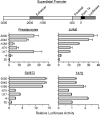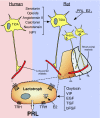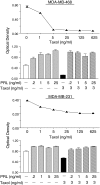What can we learn from rodents about prolactin in humans?
- PMID: 18057139
- PMCID: PMC2244934
- DOI: 10.1210/er.2007-0017
What can we learn from rodents about prolactin in humans?
Abstract
Prolactin (PRL) is a 23-kDa protein hormone that binds to a single-span membrane receptor, a member of the cytokine receptor superfamily, and exerts its action via several interacting signaling pathways. PRL is a multifunctional hormone that affects multiple reproductive and metabolic functions and is also involved in tumorigenicity. In addition to being a classical pituitary hormone, PRL in humans is produced by many tissues throughout the body where it acts as a cytokine. The objective of this review is to compare and contrast multiple aspects of PRL, from structure to regulation, and from physiology to pathology in rats, mice, and humans. At each juncture, questions are raised whether, or to what extent, data from rodents are relevant to PRL homeostasis in humans. Most current knowledge on PRL has been obtained from studies with rats and, more recently, from the use of transgenic mice. Although this information is indispensable for understanding PRL in human health and disease, there is sufficient disparity in the control of the production, distribution, and physiological functions of PRL among these species to warrant careful and judicial extrapolation to humans.
Figures











References
-
- Forsyth IA, Wallis M 2002 Growth hormone and prolactin–molecular and functional evolution. J Mammary Gland Biol Neoplasia 7:291–312 - PubMed
-
- Handwerger S, Freemark M 2000 The roles of placental growth hormone and placental lactogen in the regulation of human fetal growth and development. J Pediatr Endocrinol Metab 13:343–356 - PubMed
-
- Goffin V, Binart N, Touraine P, Kelly PA 2002 Prolactin: the new biology of an old hormone. Annu Rev Physiol 64:47–67 - PubMed
-
- Prigent-Tessier A, Tessier C, Hirosawa-Takamori M, Boyer C, Ferguson-Gottschall S, Gibori G 1999 Rat decidual prolactin. Identification, molecular cloning, and characterization. J Biol Chem 274:37982–37989 - PubMed
Publication types
MeSH terms
Substances
Grants and funding
LinkOut - more resources
Full Text Sources
Other Literature Sources

